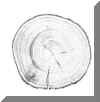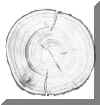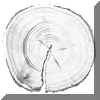Cracks
A
crack is deep split through the bark, extending into the
wood of the tree. Cracks are physical separations of the
wood (Figure 1 and 2). They can occur in stems and branches
and they may even extend up from the roots into the lower
stem. Cracks are considered to be the most hazardous defect
as they indicate the structural weakness of a tree. For
example, when a tree has two cracks in the same segment
of the stem, the stem can be separated into two sections
of wood which move independently from each other. One section
slides over the other creating tension and the crack elongates
(Hayes, 1997, Robbins, 1986).
 |
 |
| Figure
1 |
Figure
2 |
One of the most common reasons for
cracks and splits on tree trunks is frost cracking. Frost
cracks originate at a point where the trunk was physically
injured in the past. Trees growing on poorly drained soils
are particularly prone to frost cracks. Frost cracks often
close during summer, only to re-open in succeeding winters.
If cracks are only in the bark, they will not seriously
damage it, although they do provide openings where certain
disease organisms may enter the tree, particularly if the
tree is in a weakened condition. Maples and sycamores are
very prone to frost cracks while apples, ornamental crabapples,
ash, beech, horse chestnut and tulip tree are susceptible.
Isolated trees are more subject to frost cracks than trees
in groups or in forest settings.
In some cases when a scar or cavity
forms, the wound will not heal properly at the edges. The
wound tissue may roll inward as it grows, failing to close.
This process will continue and outward pressure will be
exerted on the stem, causing a crack to form.
 |
| Figure
3 |
The
evaluation of cracks is based on the number of cracks (splits),
where they occur and if they are in contact with another
defects such as, rot or a cavity. Three classes of cracks
are defined using the following rating:
| 0
|
Tree
does not have major cracks either on trunk or major
branches. |
| 1
|
One
minor crack extends into the stem, major stubs or a
branch of significant size. A minor crack is one that
enters the wood (not just in the bark) but does not
extend more than ‡ of the distance to the centre of
the stem. No "Ram’s Horn" (Figure 3) |
 |
| 2 |
Two
or more minor cracks occur in the same general area
of the stem, but there are no other defects in contact
with the cracks; The crack condition is more serious
than class 1, but less than class 3. |
 |
| 3 |
A
crack(s) is in contact with another defect (e.g. rot,
poor branch attachment, lean); Tree has one deep crack
where one-half or more of the tree diameter is structurally
compromised; A crack has "Ram’s Horn"
(Figure 3) appearance; Crack(s) in the tangential (horizontal)
plane. |
 |
Tree Problems Roots Roots
|